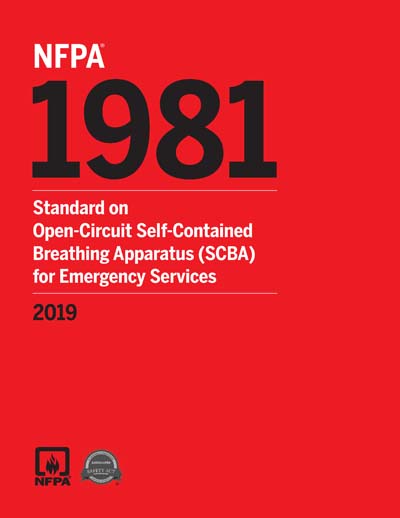Most recent
NFPA 1981-2019
NFPA 1981 Standard on Open-Circuit Self-Contained Breathing Apparatus (SCBA) for Emergency Services, 2019 edition
This standard shall specify the minimum requirements for the design, performance, testing, and certification of new compressed breathing air open-circuit self-contained breathing apparatus (SCBA) and compressed breathing air combination open-circuit self-contained breathing apparatus and supplied air respirators (SCBA/SARs) and for the replacement parts, components, and accessories for these respirators. This edition of the standard shall also specify the minimum requirements for the design, performance and testing of replacement parts, components, and add-on accessories for SCBA and combination SCBA/SARs certified as compliant to earlier editions of this standard. This standard shall not specify requirements for other types of SCBA. This standard shall not specify requirements for any accessories that could be attached to the certified product that are not certified by the National Institute for Occupational Safety and Health (NIOSH). This standard shall not establish criteria for SCBA for water or underwater operations. This standard shall not establish criteria for protection from ionizing radiation. This standard shall not be construed as addressing all of the safety concerns associated with the use of compliant SCBA and combination SCBA/SARs. It shall be the responsibility of the persons and organizations that use compliant SCBA and combination SCBA/SARs to establish safety and health practices and to determine the applicability of regulatory limitations prior to use. This standard shall not be construed as addressing all of the safety concerns, if any, associated with the use of this standard by testing facilities. It shall be the responsibility of the persons and organizations that use this standard to conduct testing of SCBA and combination SCBA/SARs to establish safety and health practices and to determine the applicability of regulatory limitations prior to using this standard for any designing, manufacturing, and testing. Nothing herein shall restrict any jurisdiction or manufacturer from exceeding these minimum requirements. The purpose of this standard shall be to establish minimum levels of protection for emergency services personnel from atmospheres that are categorized as immediately dangerous to life and health (IDLH) atmospheres. Controlled laboratory tests used to determine compliance with the performance requirements of this standard shall not be deemed as establishing performance levels for all respiratory protective situations and IDLH atmospheres to which personnel can be exposed. This standard shall not be interpreted or used as a detailed manufacturing or purchase specification but shall be permitted to be referenced in purchase specifications as minimum requirements.
Content Provider
National Fire Protection Association [nfpa]






